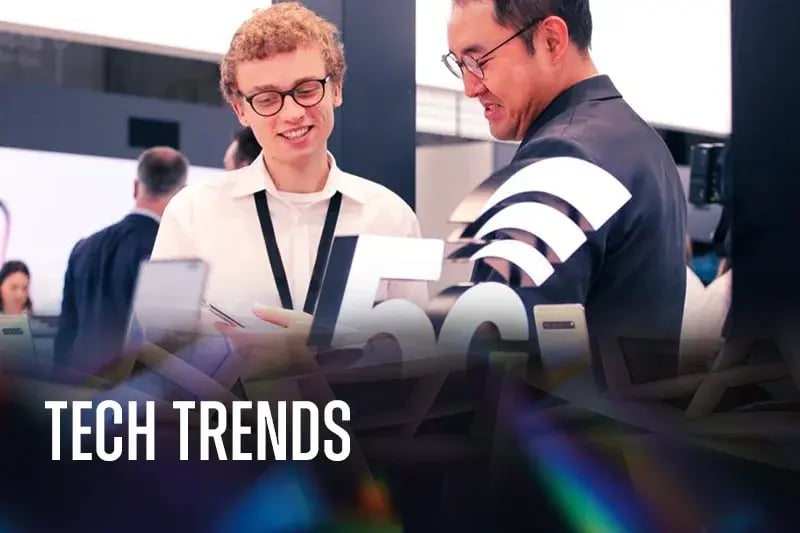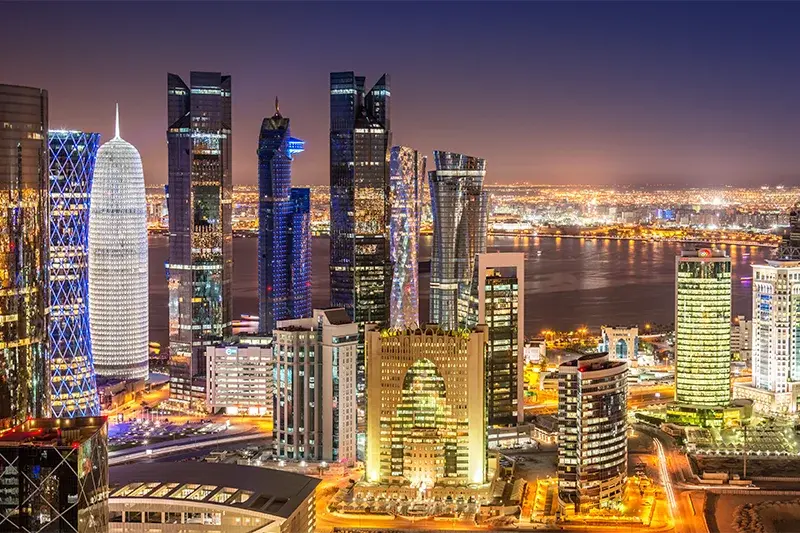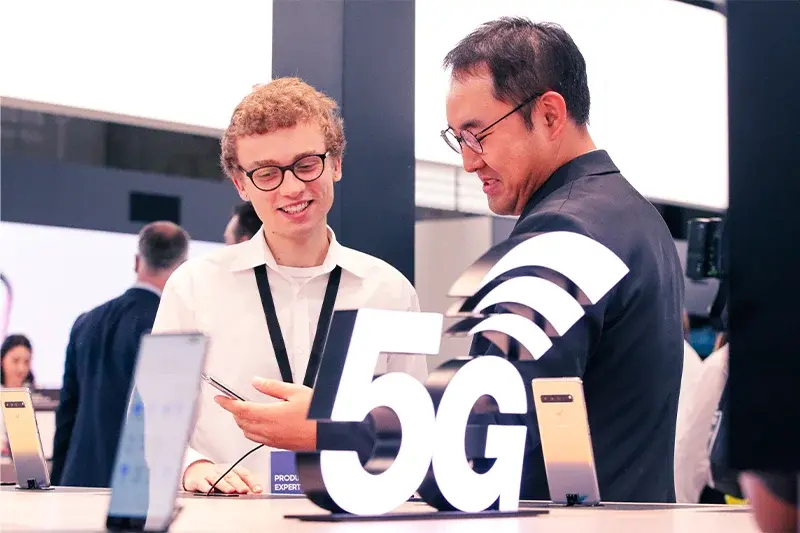Blog
Forging 5G links in the Gulf

Learn how Qatar is leaning into the network’s potential, thanks to cross-border collaboration and shared infrastructure.
The MWC Doha Tech Trends series highlights the top-agenda topics you need to know about in advance of November’s event. This article examines how Qatar’s investments in 5G, data centres and open-network APIs are supporting digital parity across the region and setting a shared stage for continued cooperation.
Find out more about our bespoke summit for all things 5G and 6G.
Supportive policy frameworks and shared solutions across the MENA region are vital to sustain 5G investment in the face of rising costs. The collaborative approach shown by Qatar and many of its neighbours is working towards wider regional progress rather than standing alone. There are many efforts underway to achieve this progress collectively – too many to cover in one short article. So here, we take a closer look at just some of those originating in Qatar, home of MWC in the Middle East.

Harnessing the world’s fastest mobile 5G
Ooredoo Group made history with its early implementation of 5G infrastructure, paving the way for the first international 5G call in the Arab world between Qatar and Kuwait in 2019. This signalled Qatar’s forward-focused role in global enterprise and regional connectivity, among Gulf countries with their own brisk rollout timetables.
This landmark moment set Qatar on a path of continuous improvement in mobile technology, a principle that runs through its Digital Agenda 2030. Today, its networks consistently rank among the world’s fastest, with average 5G download speeds above 400Mbps and some of the lowest latencies recorded globally.
Recent measurements from Speedtest show Al Rayyan and Doha to be the first- and third-fastest mobile performance cities in the world, while Qatar is the second-fastest national performer (Abu Dhabi is the second fastest city and the UAE is the top national performer, with Kuwait coming in third).
The next step for the GCC will be to follow up the strong 5G launch pipeline with plans for growth into 6 and 7 GHz.
Qatar’s role in expanding 5G interconnectivity
To sustain positive contributions to regional 5G, network-neutral Qatar maintains a connectivity stronghold at home. Longstanding partnerships with telecoms giants Ericsson and Nokia have consolidated early development of 5G and continue to expand Doha’s reputation as a technology hub for the region.
Ooredoo was named a 5G Global Leader for download speed in Opensignal’s 5G Global Mobile Network Experience Awards 2024.
In 2024, Ooredoo Group, which operates across the Middle East, North Africa, and Southeast Asia, committed over $1b to bridge the digital divide in developing markets. This work is critical to expanding the availability of 5G across its footprint and benefits are expected to reach over 109 million people. Key programmes underway include a region-first rollout of the GSMA Camara open network APIs, starting in the Maldives and progressing across MENA nations into Iraq.
In the MENA region, mobile subscriptions are projected to grow by 2% annually from 2024 to 2030, reaching as much as 830m.
Regional championing of the Open Gateway initiative shows how MENA operators can work together to standardise network APIs, with early launches in fraud prevention and security proving that shared benefits can be delivered across borders.
About Open Gateway and Camara
The GSMA Open Gateway initiative is a framework of APIs designed to provide universal developer access to operator networks. Camara is an alliance connected to the initiative providing user-friendly, open-source components. It defines, develops and publishes service APIs (such as SIM Swap, Device Roaming Status and Quality On Demand) that provide standardisation and compatibility. Representing 285 networks and almost 80% of mobile subscribers worldwide, 73 operator groups are now committed to the GSMA Open Gateway.
At MWC Doha this November, the globally respected GSMA event convenes authorities in 5G and advocates of connectivity all under one roof. Join us to share your own stories and hear of the many regional collaborations underway that foster exchange of expertise and telecoms accessibility for all.
Find out more about our dedicated 5G Futures summit.
Qatar and Ooredoo: strengthening 5G in the GCC
Elsewhere in the GCC, 5G efforts supported by Qatar and Ooredoo are progressing in chorus. Ooredoo Oman has been working with Nokia on its Dense Wavelength Division Multiplexing (DWDM) wholesale network, establishing Oman as a key connectivity hub between the Indian Ocean, the Gulf and Europe. In Kuwait, Ooredoo has a project underway with Ericsson to modernise its 5G Standalone charging infrastructure. Qatar and the Kingdom of Saudi Arabia have recently strengthened bilateral cooperation in digital infrastructure and data governance, paving the way for cross-border services and public-private partnerships.
GCC 5G subscriptions are expected to grow by 19% p.a. to 2029, when over 90% of all subscriptions are forecast to be 5G.
Bridging data gaps with MENA-based centres
For emerging economies in MENA, the path to digital transformation can be fast-tracked with regional alignments that support in-country data centre development and tap into a spirit of wide collaboration.
Supporting data centre excellence for MENA neighbours – essential to 5G success – is high on Ooredoo Group’s aspirations. Its carrier-neutral data centre company, Syntys, has teamed up with Iron Mountain to meet the rising demand for colocation, AI, cloud services and hyperconnectivity. With over 25 data centres, the multi-country provider is sharing expertise and bringing greater parity of world-class infrastructure to support digital transformation across a diverse region.
This is more important than ever as regional data traffic mirrors the global surge, demanding bigger and better network expansions. Local MENA operators are facing financial pressure to increase revenues while straddling a challenging investment gap.
It’s estimated that MENA has the highest growth in smartphone subscriptions globally.
Tech giant Nvidia announced its first large-scale Middle Eastern project with Cloud Partner Ooredoo last year. Its hyper-fast Tensor Core processors fuel unique capability and access to the full-stack AI platform across the Syntys network.

Making a splash with undersea connections in MENA
Voluntary infrastructure sharing is becoming essential to reduce the heavy costs of 5G rollout. In parts of MENA, capital expenditure accounts for as much as 40% of operator revenue, underlining the scale of investment needed to meet rising demand for connectivity. By investing in subsea cables and regional data centres, Qatar and its collaborators are creating a model for asset sharing that makes advanced connectivity more accessible to all.
Ooredoo Group’s Fibre in Gulf (FIG) project is one of the largest international subsea cables, connecting seven Gulf nations – Qatar, Kuwait, Oman, Iraq, Bahrain, the UAE and Saudi Arabia – with a new corridor into Europe. The cable provides low-latency links delivering up to 720 Tbps across 24 fibre pairs, and is expected to go live in late 2027. This subsea cable project, brought to life by Alcatel Submarine Networks, is estimated to exceed the combined capacity of all existing and planned Gulf cables.
Qatar, Kuwait and the UAE are all in the top 5 connected nations in the GSMA’s 5G Connectivity Index 2024
Also founded in Qatar and owned by the Qatar Investment Authority, Gulf Bridge International (GBI) set out in 2008 with a mission to connect Arabian Gulf countries to the rest of the world. Since then, it has become the ‘carrier’s carrier’, providing wholesale and enterprise connectivity to a dynamic global hub. It operates a multi-Tbps submarine and terrestrial smart network formed of 9 cable systems. This network spans roughly 40,000km to connect Gulf states with Europe and Asia across 17 cable landings between London and Singapore. In 2012, GBI placed the first submarine cable connecting Iraq with the world.
Ooredoo Group and UAE market leader e& joined forces in 2024 to deploy the latest subsea technology for the Gulf Gateway Cable (GGC1) system, significantly increasing existing data network capacity.
Aligning spectrum policy in MENA
Qatar’s Communications Regulatory Authority has set a deadline to close all 3G networks by the end of 2025 so that spectrum space can be reallocated to 4G and 5G. Imports of 2G and 3G devices are now barred and similar network sunsetting activity is underway across the GCC. In the wider MENA region, although smartphone use in 4G is accelerating, 2G and 3G often remain essential for basic voice and mobile internet, especially in parts of North Africa and the eastern Mediterranean. Some countries are also retaining 2G or 3G capability to support older IoT devices.
In MENA, especially in North Africa, the allocation and management of spectrum is a key consideration. Affordable spectrum prices are vital, matched with licence conditions that enable operators to meet growing data demands without diminishing returns or deterring investment. While 4G adoption is accelerating, affordable spectrum and realistic licence terms hold the key to unlocking the region’s full potential in 5G connectivity.
With 50 MENA-based members and counting, the globally repected GSMA is the region’s most important forum for telecoms operators to work towards common goals. Technology and telco giants including Ooredoo, du, e&, Batelco, Omantel, stc and Zain KSA have all made significant 5G announcements at recent MWC events.
Be there as the news breaks. Register for MWC25 Doha or find out more about exhibiting and sponsoring.
Continued 5G growth is expected in the MENA region, making up to 60% of total subscriptions by 2030 – that’s around 500 million subscriptions.
Definitions:
- 5G Standalone: a 5G network built from the ground up with 5G technology, rather than relying on existing 4G infrastructure.
- Dense Wavelength Division Multiplexing (DWDM) wholesale network: fibre-optic technology which transmits multiple data streams over different light wavelengths through a single fibre.


